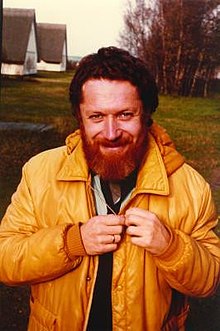Leonid Abramowitsch Bunimowitsch
Leonid Abramowitsch Bunimowitsch ( Russian Леонид Абрамович Бунимович , English transcription Leonid Bunimovich ; born August 1, 1947 in Moscow ) is a Russian-American mathematician who deals with dynamic systems, chaos theory and ergodic theory.
Bunimowitsch made his diploma in 1969 at the Lomonosov University , where he received his doctorate in 1973 with Jakow Grigoryevich Sinai (with a topic from probability theory). Afterwards at various institutes (such as the Institute of Psychiatry of the Medical Academy of the USSR from 1972 to 1976, the Research Institute for Paper) and 1978 to 1992 senior scientist at the Institute of Oceanography of the Soviet Academy of Sciences. In 1986 he completed his habilitation (Russian doctorate) at the Institute for Theoretical Physics of the Academy of Sciences in Kiev . In 1989/90 he was visiting professor at the Courant Institute of Mathematical Sciences of New York University and at Rutgers University and in 1990/91 professor at Bielefeld University . From 1991 he was a professor at the Georgia Institute of Technology . From 1998 he was Regent's professor there .
In 1995 he was visiting scholar at the Isaac Newton Institute .
He is known for his study of billiards in the theory of chaotic dynamic systems named after him.
He deals with applications of the theory of dynamic systems and chaos theory in various areas such as geophysics (oceanography), mathematical biology and neuroscience, operations research, statistical mechanics, lattice gases, cellular automata, percolation and quantum chaos.
Fonts
- Dynamical systems, ergodic theory and applications , in Sinai (ed) Encyclopaedia of Mathematical Sciences, Springer Verlag, 2000, ISBN 978-3-540-66316-4
- Hard ball systems and the Lorentz gas , in Domokos Szasz (ed) Encyclopaedia of Mathematical Sciences, Springer Verlag 2000
Web links
Individual evidence
- ↑ Life data according to American Men and Women of Science , Thomson Gale 2004
- ↑ Mathematics Genealogy Projec
| personal data | |
|---|---|
| SURNAME | Bunimowitsch, Leonid Abramowitsch |
| ALTERNATIVE NAMES | Бунимович, Леонид Абрамович (Russian); Bunimovich, Leonid |
| BRIEF DESCRIPTION | Russian mathematician |
| DATE OF BIRTH | August 1, 1947 |
| PLACE OF BIRTH | Moscow |
